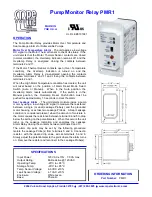
⎯
42
⎯
6 F 2 S 0 8 2 8
2.9 Breaker Failure Protection
Two stage breaker failure protection provides outputs for re-tripping of the local circuit breaker
and/or back-tripping to upstream circuit breakers. The functions can also be initiated by external
protections via a binary input if required.
When fault clearance fails due to a breaker failure, the breaker failure protection (BFP) clears the
fault by back-tripping adjacent circuit breakers.
If the current continues to flow even after a trip command is output, the BFP judges it as a breaker
failure. The existence of the current is detected by an overcurrent element provided for each phase.
For high-speed operation of the BFP, a high-speed reset overcurrent element (less than 20ms) is
used. The element resets when the current falls below 80% of the operating value.
In order to prevent the BFP from starting by accident during maintenance work and testing, and
thus tripping upstream breakers, the BFP has the optional function of re-tripping the local breaker.
To make sure that the breaker has actually failed, a trip command is made to the local breaker
again before tripping the upstream breakers to prevent unnecessary tripping of the upstream
breakers following the erroneous start-up of the BFP. It is possible to choose not to use re-tripping
at all, or use re-tripping with trip command plus delayed pick-up timer, or re-tripping with trip
command plus overcurrent detection plus delayed pick-up timer.
An overcurrent element and delayed pick-up timer are provided for each phase which also operate
correctly during the breaker failure routine in the event of an evolving fault.
2.9.1 Scheme
Logic
The BFP is performed on per-phase basis. Figure 2.9.1.1 shows the scheme logic for the BFP. The
BFP is started by the PLC logic per-phase base signals [CBF_INIT-A] to [CBF_INIT-C] or
three-phase base signal [CBF_INIT]. The BFP can be disabled by the PLC logic signal
[CBF_BLOCK]. These signals must continuously exist as long as the fault is present. The BFP can
be disabled by the PLC logic signal [CBF_BLOCK].
The back-tripping signal to the upstream breakers CBF TRIP is output if the overcurrent element
CBF operates continuously for the setting time of the delayed pick-up timer TBTC after initiation.
Tripping of upstream breakers can be blocked with the scheme switch [BTC].
There are two kinds of modes of the re-trip signal to the local breaker CBF RETRIP, the mode in
which re-trip is controlled by the overcurrent element CBF, and the direct trip mode in which
re-trip is not controlled. The re-trip mode together with the trip block can be selected with the
scheme switch [RTC]. In the scheme switch [RTC], “DIR” is the direct trip mode, and “OC” is the
trip mode controlled by the overcurrent element CBF.
Figure 2.9.1.2 shows a sequence diagram for the BFP when a re-trip and backup trip are used. If
the circuit breaker trips normally, the CBF is reset before timer TRTC or TBTC is picked up and
the BFP is reset. As TRTC and TBTC start at the same time, the setting value of TBTC should
include that of TRTC.
If the CBF continues to operate, a re-trip command is given to the local breaker after the setting
time of TRTC. Unless the breaker fails, the CBF is reset by re-trip. TBTC does not time-out and
the BFP is reset. This sequence of events may happen if the BFP is initiated by mistake and
unnecessary tripping of the local breaker is unavoidable.
If the local breaker fails, re-trip has no effect and the CBF continues operating and the TBTC
finally picks up. A trip command CBF TRIP is given to the upstream breakers and the BFP is
completed.
Summary of Contents for GRL150-100 Series
Page 149: ... 148 6 F 2 S 0 8 2 8 ...
Page 154: ... 153 6 F 2 S 0 8 2 8 Appendix B Signal List ...
Page 180: ... 179 6 F 2 S 0 8 2 8 Appendix C Binary Output Default Setting List ...
Page 182: ... 181 6 F 2 S 0 8 2 8 Appendix D Details of Relay Menu ...
Page 195: ... 194 6 F 2 S 0 8 2 8 ...
Page 196: ... 195 6 F 2 S 0 8 2 8 Appendix E Case Outline ...
Page 199: ... 198 6 F 2 S 0 8 2 8 ...
Page 200: ... 199 6 F 2 S 0 8 2 8 Appendix F Typical External Connections ...
Page 223: ... 222 6 F 2 S 0 8 2 8 ...
Page 228: ... 227 6 F 2 S 0 8 2 8 Appendix I Return Repair Form ...
Page 232: ... 231 6 F 2 S 0 8 2 8 Appendix J Technical Data ...
Page 238: ... 237 6 F 2 S 0 8 2 8 Appendix K Symbols Used in Scheme Logic ...
Page 241: ... 240 6 F 2 S 0 8 2 8 ...
Page 242: ... 241 6 F 2 S 0 8 2 8 Appendix L Inverse Time Characteristics ...
Page 248: ... 247 6 F 2 S 0 8 2 8 Appendix M IEC60870 5 103 Interoperability ...
Page 260: ... 259 6 F 2 S 0 8 2 8 Appendix N Resistor Box Option ...
Page 263: ... 262 6 F 2 S 0 8 2 8 ...
Page 264: ... 263 6 F 2 S 0 8 2 8 Appendix O Ordering ...
Page 267: ......
















































